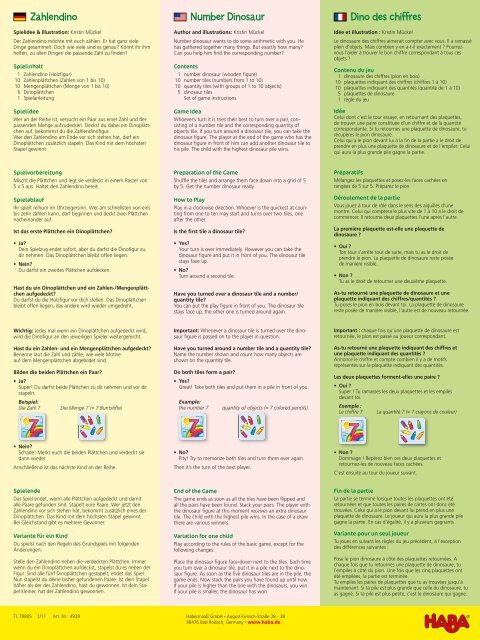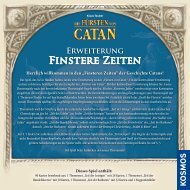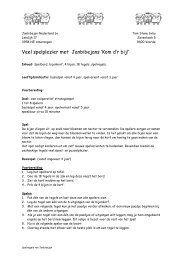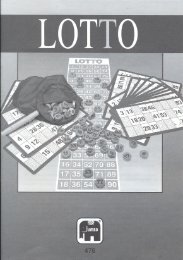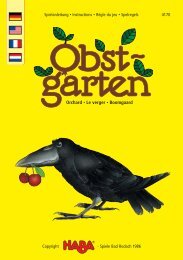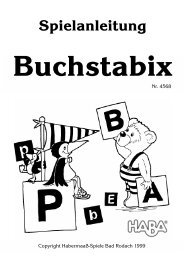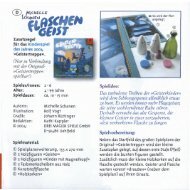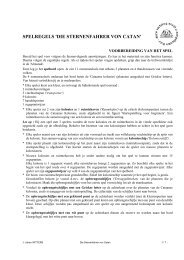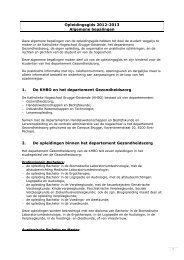Zahlendino Number Dinosaur Dino des chiffres dinosaur
Zahlendino Number Dinosaur Dino des chiffres - Haba
Zahlendino Number Dinosaur Dino des chiffres - Haba
Create successful ePaper yourself
Turn your PDF publications into a flip-book with our unique Google optimized e-Paper software.
<strong>Zahlendino</strong><br />
Spielidee & Illustration: Kristin Mückel<br />
Der <strong>Zahlendino</strong> möchte mit euch zählen. Er hat ganz viele<br />
Dinge gesammelt. Doch wie viele sind es genau? Könnt ihr ihm<br />
helfen, zu allen Dingen die passende Zahl zu finden?<br />
Spielinhalt<br />
1 <strong>Zahlendino</strong> (Holzfigur)<br />
10 Zahlenplättchen (Zahlen von 1 bis 10)<br />
10 Mengenplättchen (Menge von 1 bis 10)<br />
5 <strong>Dino</strong>plättchen<br />
1 Spielanleitung<br />
Spielidee<br />
Wer an der Reihe ist, versucht ein Paar aus einer Zahl und der<br />
passenden Menge aufzudecken. Deckst du dabei ein <strong>Dino</strong>plättchen<br />
auf, bekommst du die <strong>Zahlendino</strong>figur.<br />
Wer den <strong>Zahlendino</strong> am Ende vor sich stehen hat, darf ein<br />
<strong>Dino</strong>plättchen zusätzlich stapeln. Das Kind mit dem höchsten<br />
Stapel gewinnt.<br />
<strong>Number</strong> <strong><strong>Dino</strong>saur</strong><br />
Author and illustrations: Kristin Mückel<br />
<strong>Number</strong> <strong>dinosaur</strong> wants to do some arithmetic with you. He<br />
has gathered together many things. But exactly how many?<br />
Can you help him find the corresponding number?<br />
Contents<br />
1 number <strong>dinosaur</strong> (wooden figure)<br />
10 number tiles (numbers from 1 to 10)<br />
10 quantity tiles (with groups of 1 to 10 objects)<br />
5 <strong>dinosaur</strong> tiles<br />
Set of game instructions<br />
Game Idea<br />
Whoever’s turn it is tries their best to turn over a pair, consisting<br />
of a number tile and the corresponding quantity of<br />
objects tile. If you turn around a <strong>dinosaur</strong> tile, you can take the<br />
<strong>dinosaur</strong> figure. The player at the end of the game who has the<br />
<strong>dinosaur</strong> figure in front of him can add another <strong>dinosaur</strong> tile to<br />
his pile. The child with the highest <strong>dinosaur</strong> pile wins.<br />
<strong>Dino</strong> <strong>des</strong> <strong>chiffres</strong><br />
Idée et illustration : Kristin Mückel<br />
Le <strong>dinosaur</strong>e <strong>des</strong> <strong>chiffres</strong> aimerait compter avec vous. Il a ramassé<br />
plein d’objets. Mais combien y en a-t-il exactement ? Pourrezvous<br />
l’aider à trouver le bon chiffre correspondant à tous ces<br />
objets ?<br />
Contenu du jeu<br />
1 <strong>dinosaur</strong>e <strong>des</strong> <strong>chiffres</strong> (pion en bois)<br />
10 plaquettes indiquant <strong>des</strong> <strong>chiffres</strong> (<strong>chiffres</strong> 1 à 10)<br />
10 plaquettes indiquant <strong>des</strong> quantités (quantité de 1 à 10)<br />
5 plaquettes de <strong>dinosaur</strong>e<br />
1 règle du jeu<br />
Idée<br />
Celui dont c’est le tour essaye, en retournant <strong>des</strong> plaquettes,<br />
de trouver une paire constituée d’un chiffre et de la quantité<br />
correspondante. Si tu retournes une plaquette de <strong>dinosaur</strong>e, tu<br />
récupères le pion <strong>dinosaur</strong>e.<br />
Celui qui a le pion devant lui à la fin de la partie a le droit de<br />
prendre en plus une plaquette de <strong>dinosaur</strong>e et de l’empiler. Celui<br />
qui aura la plus grande pile gagne la partie.<br />
Spielvorbereitung<br />
Mischt die Plättchen und legt sie verdeckt in einem Raster von<br />
5 x 5 aus. Haltet den <strong>Zahlendino</strong> bereit.<br />
Spielablauf<br />
Ihr spielt reihum im Uhrzeigersinn. Wer am schnellsten von eins<br />
bis zehn zählen kann, darf beginnen und deckt zwei Plättchen<br />
nacheinander auf.<br />
Ist das erste Plättchen ein <strong>Dino</strong>plättchen?<br />
• Ja?<br />
Dein Spielzug endet sofort, aber du darfst die <strong>Dino</strong>figur zu<br />
dir nehmen. Das <strong>Dino</strong>plättchen bleibt offen liegen.<br />
• Nein?<br />
Du darfst ein zweites Plättchen aufdecken.<br />
Hast du ein <strong>Dino</strong>plättchen und ein Zahlen-/Mengenplättchen<br />
aufgedeckt?<br />
Du darfst du die Holzfigur vor dich stellen. Das <strong>Dino</strong>plättchen<br />
bleibt offen liegen, das andere wird wieder umgedreht.<br />
Preparation of the Game<br />
Shuffle the tiles and arrange them face down into a grid of 5<br />
by 5. Get the number <strong>dinosaur</strong> ready.<br />
How to Play<br />
Play in a clockwise direction. Whoever is the quickest at counting<br />
from one to ten may start and turns over two tiles, one<br />
after the other.<br />
Is the first tile a <strong>dinosaur</strong> tile?<br />
• Yes?<br />
Your turn is over immediately. However you can take the<br />
<strong>dinosaur</strong> figure and put it in front of you. The <strong>dinosaur</strong> tile<br />
stays face up.<br />
• No?<br />
Turn around a second tile.<br />
Have you turned over a <strong>dinosaur</strong> tile and a number/<br />
quantity tile?<br />
You can put the play figure in front of you. The <strong>dinosaur</strong> tile<br />
stays face up, the other one is turned around again.<br />
Préparatifs<br />
Mélangez les plaquettes et posez-les faces cachées en<br />
rangées de 5 sur 5. Préparez le pion.<br />
Déroulement de la partie<br />
Vous jouez à tour de rôle dans le sens <strong>des</strong> aiguilles d’une<br />
montre. Celui qui comptera le plus vite de 1 à 10 a le droit de<br />
commencer. Il retourne deux plaquettes l’une après l’autre.<br />
La première plaquette est-elle une plaquette de<br />
<strong>dinosaur</strong>e ?<br />
• Oui ?<br />
Ton tour s’arrête tout de suite, mais tu as le droit de<br />
prendre le pion. La plaquette de <strong>dinosaur</strong>e reste posée<br />
de manière visible.<br />
• Non ?<br />
Tu as le droit de retourner une deuxième plaquette.<br />
As-tu retourné une plaquette de <strong>dinosaur</strong>e et une<br />
plaquette indiquant <strong>des</strong> <strong>chiffres</strong>/quantités ?<br />
Tu poses le pion en bois devant toi. La plaquette de <strong>dinosaur</strong>e<br />
reste posée de manière visible, l’autre est de nouveau retournée.<br />
Wichtig: Je<strong>des</strong> mal wenn ein <strong>Dino</strong>plättchen aufgedeckt wird,<br />
wird die <strong>Dino</strong>figur an den jeweiligen Spieler weitergereicht.<br />
Important: Whenever a <strong>dinosaur</strong> tile is turned over the <strong>dinosaur</strong><br />
figure is passed on to the player in question.<br />
Important : chaque fois qu’une plaquette de <strong>dinosaur</strong>e est<br />
retournée, le pion est passé au joueur correspondant.<br />
Hast du ein Zahlen- und ein Mengenplättchen aufgedeckt?<br />
Benenne laut die Zahl und zähle, wie viele Motive<br />
auf dem Mengenplättchen abgebildet sind.<br />
Have you turned around a number tile and a quantity tile?<br />
Name the number shown and count how many objects are<br />
shown on the quantity tile.<br />
Bilden die beiden Plättchen ein Paar?<br />
• Ja?<br />
Super! Du darfst beide Plättchen zu dir nehmen und vor dir<br />
Do both tiles form a pair?<br />
• Yes?<br />
Great! Take both tiles and put them in a pile in front of you.<br />
stapeln.<br />
Beispiel:<br />
Die Zahl 7 Die Menge 7 (= 7 Buntstifte)<br />
Example:<br />
the number 7 quantity of objects (= 7 colored pencils)<br />
As-tu retourné une plaquette indiquant <strong>des</strong> <strong>chiffres</strong> et<br />
une plaquette indiquant <strong>des</strong> quantités ?<br />
Annonce le chiffre et compte combien il y a de motifs<br />
représentés sur la plaquette indiquant <strong>des</strong> quantités.<br />
Les deux plaquettes forment-elles une paire ?<br />
• Oui ?<br />
Super ! Tu ramasses les deux plaquettes et les empiles<br />
devant toi.<br />
Exemple :<br />
Le chiffre 7 La quantité 7 (= 7 crayons de couleur)<br />
• Nein?<br />
Schade! Merkt euch die beiden Plättchen und verdeckt sie<br />
dann wieder.<br />
Anschließend ist das nächste Kind an der Reihe.<br />
• No?<br />
Pity! Try to memorize both tiles and turn them over again.<br />
Then it’s the turn of the next player.<br />
• Non ?<br />
Dommage ! Repérez bien ces deux plaquettes et<br />
retournez-les de nouveau faces cachées.<br />
C’est ensuite au tour du joueur suivant.<br />
Spielende<br />
Das Spiel endet, wenn alle Plättchen aufgedeckt und damit<br />
alle Paare gefunden sind. Stapelt eure Paare. Wer jetzt den<br />
<strong>Zahlendino</strong> vor sich stehen hat, bekommt zusätzlich eines der<br />
<strong>Dino</strong>plättchen. Das Kind mit dem höchsten Stapel gewinnt.<br />
Bei Gleichstand gibt es mehrere Gewinner.<br />
Variante für ein Kind<br />
Du spielst nach den Regeln <strong>des</strong> Grundspiels mit folgenden<br />
Änderungen:<br />
Stelle den <strong>Zahlendino</strong> neben die verdeckten Plättchen. Immer<br />
wenn du ein <strong>Dino</strong>plättchen aufdeckst, stapelst du es neben der<br />
Figur. Sind alle fünf <strong>Dino</strong>plättchen gestapelt, endet das Spiel.<br />
Nun stapelst du deine bisher gefundenen Paare. Ist dein Stapel<br />
höher als der <strong>des</strong> <strong>Zahlendino</strong>, hast du gewonnen. Ist dein Stapel<br />
kleiner, hat der <strong>Zahlendino</strong> gewonnen.<br />
End of the Game<br />
The game ends as soon as all the tiles have been flipped and<br />
all the pairs have been found. Stack your pairs. The player with<br />
the <strong>dinosaur</strong> figure at this moment receives an extra <strong>dinosaur</strong><br />
tile. The child with the highest pile wins. In the case of a draw<br />
there are various winners.<br />
Variation for one child<br />
Play according to the rules of the basic game, except for the<br />
following changes:<br />
Place the <strong>dinosaur</strong> figure face-down next to the tiles. Each time<br />
you turn over a <strong>dinosaur</strong> tile, put it in a pile next to the <strong>dinosaur</strong><br />
figure. As soon as the five <strong>dinosaur</strong> tiles are in the pile, the<br />
game ends. Now stack the pairs you have found up until now.<br />
If your pile is higher than the one with the <strong>dinosaur</strong>s, you win.<br />
If your pile is smaller, the <strong>dinosaur</strong> has won.<br />
Fin de la partie<br />
La partie se termine lorsque toutes les plaquettes ont été<br />
retournées et que toutes les paires de cartes ont donc été<br />
trouvées. Celui qui a le pion devant lui prend en plus une<br />
plaquette de <strong>dinosaur</strong>e. Le joueur qui aura la plus grande pile<br />
gagne la partie. En cas d’égalité, il y a plusieurs gagnants.<br />
Variante pour un seul joueur<br />
Tu joues en suivant les règles du jeu précédent, à l’exception<br />
<strong>des</strong> différences suivantes :<br />
Pose le pion <strong>dinosaur</strong>e à côté <strong>des</strong> plaquettes retournées. A<br />
chaque fois que tu retournes une plaquette de <strong>dinosaur</strong>e, tu<br />
l’empiles à côté du pion. Une fois que les cinq plaquettes ont<br />
été empilées, la partie est terminée.<br />
Tu empiles les paires de plaquettes que tu as trouvées jusqu’à<br />
maintenant. Si ta pile est plus grande que celle du <strong>dinosaur</strong>e, tu<br />
as gagné. Si ta pile est plus petite, c’est le <strong>dinosaur</strong>e qui gagne.<br />
TL 79805 1/11 Art. Nr.: 4928<br />
Habermaaß GmbH • August-Grosch-Straße 28 - 38<br />
96476 Bad Rodach, Germany • www.haba.de
Getallendino<br />
Spelidee & Illustraties: Kristin Mückel<br />
De getallendino heeft zin om samen met jullie te tellen. Hij<br />
heeft een heleboel dingen verzameld. Maar hoeveel zijn het<br />
er eigenlijk? Kunnen jullie hem helpen om bij alle dingen het<br />
bijpassende getal te vinden?<br />
Spelinhoud<br />
1 getallendino (houten figuur)<br />
10 getallenkaartjes (getallen van 1 tot 10)<br />
10 kwantumkaartjes (hoeveelheden van 1 tot 10)<br />
5 dinokaartjes<br />
spelregels<br />
Spelidee<br />
Wie aan de beurt is, probeert een paar om te draaien dat uit<br />
een getal en de bijbehorende hoeveelheid bestaat. Wanneer je<br />
een dinokaartje omdraait, krijg je de houten getallendino.<br />
Wie op het eind de getallendino voor zich heeft staan, mag<br />
een dinokaartje op zijn stapel leggen. Het kind met de hoogste<br />
stapel wint.<br />
<strong>Dino</strong> de los números<br />
Autora e ilustradora: Kristin Mückel<br />
El <strong>Dino</strong> de los números quiere jugar con vosotros. Ha reunido<br />
muchas cosas, pero ¿cuántas son exactamente? ¿Podéis<br />
ayudarlo a encontrar el número correspondiente a todas las<br />
cantida<strong>des</strong> de cosas?<br />
Contenido del juego<br />
1 <strong>Dino</strong> de los números (figura de madera)<br />
10 fichas de números (números del 1 a 10)<br />
10 ichas de cantida<strong>des</strong> (cantida<strong>des</strong> del 1 al 10)<br />
5 fichas de <strong>dinosaur</strong>io<br />
1 instrucciones del juego<br />
El juego<br />
El jugador en posesión del turno intenta encontrar entre las<br />
fichas una pareja consistente en un número y su cantidad correspondiente.<br />
Si al hacerlo da la vuelta a una ficha de <strong>dinosaur</strong>io,<br />
recibirá entonces la figura de <strong>Dino</strong>.<br />
Quien al final tenga la figura de <strong>Dino</strong> delante conseguirá una<br />
ficha de <strong>dinosaur</strong>io adicional para su montón de fichas conseguidas.<br />
Gana el niño con el montón más alto.<br />
<strong><strong>Dino</strong>saur</strong>o dei numeri<br />
Autrice ed illustratrice: Kristin Mückel<br />
Il <strong>dinosaur</strong>o dei numeri vi invita a contare insieme a lui! Ha<br />
raccolto molte cose. Ma quante sono? Lo aiutate a trovarne il<br />
numero corrispondente?<br />
Contenuto del gioco<br />
1 <strong><strong>Dino</strong>saur</strong>o dei numeri (figura in legno)<br />
10 cartoncini dei numeri (da 1 a 10)<br />
10 cartoncini di quantità (da 1 a 10)<br />
5 cartoncini <strong>dinosaur</strong>i<br />
Istruzioni per giocare<br />
Ideazione<br />
Il giocatore di turno cerca di scoprire una coppia composta da<br />
un numero e dalla sua quantità corrispondente. Se però scopre<br />
un cartoncino <strong>dinosaur</strong>o, riceve la figura del <strong>dinosaur</strong>o dei<br />
numeri.<br />
Chi alla fine sarà in possesso del <strong>dinosaur</strong>o dei numeri potrà<br />
inoltre accumulare un cartoncino <strong>dinosaur</strong>o. Vince chi ha il<br />
mazzo più alto.<br />
Spelvoorbereiding<br />
Schud alle kaartjes en leg ze verdekt in een vierkant van 5 x 5<br />
op tafel. Zet de getallendino klaar.<br />
Spelverloop<br />
Er wordt kloksgewijs om de beurt gespeeld. Wie het snelst van<br />
1 tot 10 kan tellen, mag beginnen en draait twee kaartjes om.<br />
Is het eerste kaartje een dinokaartje?<br />
• Ja?<br />
Je beurt is voorbij maar je mag de getallendino pakken. Het<br />
dinokaartje blijft open op tafel liggen.<br />
• Nee?<br />
Je mag nog een kaartje omdraaien.<br />
Heb je een dinokaartje en een getallen-/kwantumkaartje<br />
omgedraaid?<br />
Je mag de houten figuur voor je zetten. Het dinokaartje blijft<br />
open liggen, het andere wordt weer omgekeerd.<br />
Preparativos<br />
Mezclad las fichas y colocadlas boca abajo formando un cuadrado<br />
de 5 x 5 fichas. Tened preparado al <strong>Dino</strong> de los números.<br />
¿Cómo se juega?<br />
Vais a jugar por turnos en el sentido de las agujas del reloj.<br />
Comienza dando la vuelta a dos fichas, una tras otra, aquél de<br />
vosotros que más rápidamente sepa contar de uno a diez.<br />
La primera ficha girada, ¿es un <strong>dinosaur</strong>io?<br />
• ¿Sí?<br />
Tu tirada acaba en ese momento, pero te quedas con la figura<br />
de <strong>Dino</strong>. La ficha <strong>des</strong>tapada se queda boca arriba.<br />
• ¿No?<br />
Debes dar la vuelta a una segunda ficha.<br />
¿Has dado la vuelta a un ficha de <strong>dinosaur</strong>io y una ficha<br />
de números o de cantida<strong>des</strong>?<br />
Ponte la figurita delante de ti. La ficha de <strong>dinosaur</strong>io permanecerá<br />
boca arriba; hay que volver a dar la vuelta a la otra ficha.<br />
Preparativi del gioco<br />
Mescolate i cartoncini e disponeteli coperti in un reticolo di 5 x<br />
5. Preparate il <strong>dinosaur</strong>o dei numeri.<br />
Svolgimento del gioco<br />
Giocate in senso orario. Inizia chi sa contare più velocemente<br />
da 1 a 10 e scopre uno dopo l’altro due cartoncini.<br />
Il primo cartoncino è quello del <strong>dinosaur</strong>o?<br />
• Si?<br />
Il tuo turno finisce, ma puoi prenderti la figura del <strong>dinosaur</strong>o.<br />
Il cartoncino del <strong>dinosaur</strong>o resta scoperto.<br />
• No?<br />
Puoi scoprire un secondo cartoncino.<br />
Hai scoperto un cartoncino <strong>dinosaur</strong>o e un cartoncino dei<br />
numeri/di quantità?<br />
Puoi mettere davanti a te la figura in legno. Il cartoncino<br />
<strong>dinosaur</strong>o resta scoperto davanti a te, l’altro viene girato.<br />
Belangrijk: telkens als er een dinokaartje wordt omgedraaid,<br />
wordt de houten dino aan de betreffende speler doorgegeven.<br />
Heb je een getallen- en een kwantumkaartje omgedraaid?<br />
Noem hardop het getal en tel hoeveel afbeeldingen op het<br />
kwantumkaartje staan afgebeeld.<br />
Vormen de twee kaartjes een paar?<br />
• Ja?<br />
Geweldig! Je mag beide kaartjes pakken en voor je op een<br />
stapel leggen.<br />
Voorbeeld:<br />
Het getal 7 De hoeveelheid 7 (= 7 kleurpotloden)<br />
Importante: Cada vez que un jugador da la vuelta a una ficha<br />
de <strong>dinosaur</strong>io, la figura de <strong>Dino</strong> va a parar a ese jugador.<br />
¿Has dado la vuelta a una ficha de números y a una ficha<br />
de cantida<strong>des</strong>?<br />
Di en voz alta el número y cuenta cuántos motivos hay dibujados<br />
en la ficha de cantida<strong>des</strong>.<br />
Las dos fichas <strong>des</strong>tapadas, ¿forman pareja?<br />
• ¡Sí!<br />
¡Fantástico! Te quedas las dos fichas y las apilas formando un<br />
montón.<br />
Ejemplo:<br />
El número 7 La cantidad 7 (= 7 lápices de colores)<br />
Importante: Ogni volta che viene scoperto un cartoncino <strong>dinosaur</strong>o,<br />
la figura in legno passa al rispettivo giocatore.<br />
Hai scoperto un cartoncino dei numeri e uno di quantità?<br />
Ad alta voce dì il numero e conta quanti motivi ci sono sul<br />
cartoncino di quantità.<br />
I due cartoncini formano una coppia?<br />
• Si?<br />
Magnifico! Puoi prenderti i due cartoncini e metterli davanti<br />
a te.<br />
Esempio:<br />
Il numero 7 La quantità 7 (=7 matite colorate)<br />
• Nee?<br />
Helaas! Probeer de beide kaartjes te onthouden en keer ze<br />
vervolgens om.<br />
Daarna is het volgende kind aan de beurt.<br />
• ¡No!<br />
¡Qué pena! Retened en la memoria las dos fichas giradas y<br />
volved a darles la vuelta a continuación.<br />
A continuación es el turno del siguiente niño.<br />
• No?<br />
Peccato! Memorizzate i due cartoncini e copriteli di nuovo.<br />
Il turno passa poi al seguente bambino.<br />
Einde van het spel<br />
Het spel is afgelopen als alle kaartjes zijn omgedraaid en dus<br />
alle paren zijn gevonden. Iedereen legt zijn paren op een stapel.<br />
Wie nu de getallendino voor zich heeft staan, krijgt bovendien<br />
een van de dinokaartjes. Het kind met de hoogste stapel wint.<br />
Bij gelijkspel zijn er meerdere winnaars.<br />
Variant voor één kind<br />
Je speelt volgens de regels van het basisspel, afgezien van de<br />
volgende wijzigingen:<br />
Zet de getallendino naast de omgekeerde kaartjes. Telkens als<br />
je een dinokaartje omdraait, leg je het op een stapel naast de<br />
houten dino. Als alle vijf dinokaartjes zijn opgestapeld, is het<br />
spel afgelopen.<br />
Nu leg je alle paren die je hebt gevonden op een stapel. Als<br />
de stapel hoger is dan de stapel van de getallendino, heb<br />
je gewonnen. Is je stapel kleiner, dan heeft de getallendino<br />
gewonnen.<br />
Final del juego<br />
La partida acaba cuando se ha dado la vuelta a todas las fichas<br />
y se han formado, por consiguiente, todas las parejas. Formad<br />
un montón con todas vuestras parejas conseguidas. El jugador<br />
que tenga en ese momento la figura de <strong>Dino</strong> recibe una ficha<br />
de <strong>dinosaur</strong>io adicional. Gana el niño con el montón de fichas<br />
más alto. En caso de empate serán varios los ganadores.<br />
Variante para un niño<br />
Vas a jugar siguiendo las reglas del juego básico pero con los<br />
siguientes cambios:<br />
Coloca la figura de <strong>Dino</strong> al lado de las fichas que están boca<br />
abajo. Cada vez que <strong>des</strong> la vuelta a una ficha de <strong>dinosaur</strong>io, lo<br />
colocas al lado de la figura formando un montón. La partida<br />
acaba cuando has apilado las cinco fichas de <strong>dinosaur</strong>ios.<br />
Ahora formas un montón con los pares de fichas que has encontrado<br />
hasta ese momento. Si tu montón es más alto que el<br />
de <strong>Dino</strong>, ganas tú. Si tu montón es más pequeño, gana <strong>Dino</strong>.<br />
Conclusione del gioco<br />
Il gioco finisce quando sono stati scoperti tutti i cartoncini e<br />
quindi sono state costituite tutte le coppie. Formate un mazzo<br />
con le vostre coppie, chi ha la figura del <strong>dinosaur</strong>o riceve in più<br />
un cartoncino <strong>dinosaur</strong>o. Vince il bambino con il mazzo più<br />
alto. In caso di parità ci saranno più vincitori.<br />
Variante per 1 bambino<br />
Giochi secondo le regole di base considerando le seguenti<br />
variazioni:<br />
Metti il <strong>dinosaur</strong>o dei numeri accanto ai cartoncini coperti.<br />
Quando scopri un cartoncino <strong>dinosaur</strong>o lo deponi accanto<br />
alla figura. Se hai raccolto i 5 cartoncini <strong>dinosaur</strong>o, il gioco si<br />
conclude. A<strong>des</strong>so formi un mazzo con le coppie che hai trovato<br />
fino ad ora. Hai vinto se il mazzo è più alto di quello del <strong>dinosaur</strong>o<br />
dei numeri. In caso contrario ha vinto invece il <strong>dinosaur</strong>o<br />
dei numeri.


